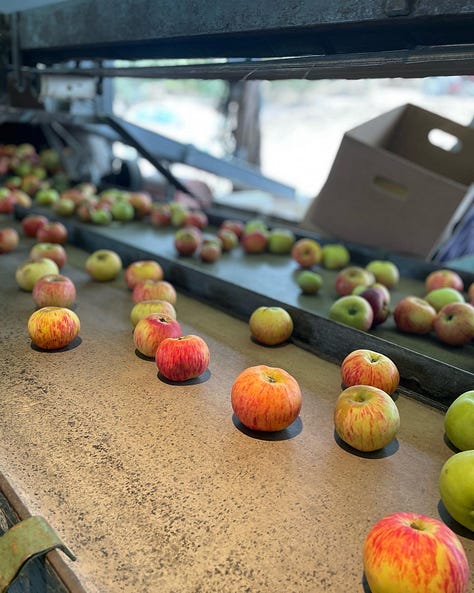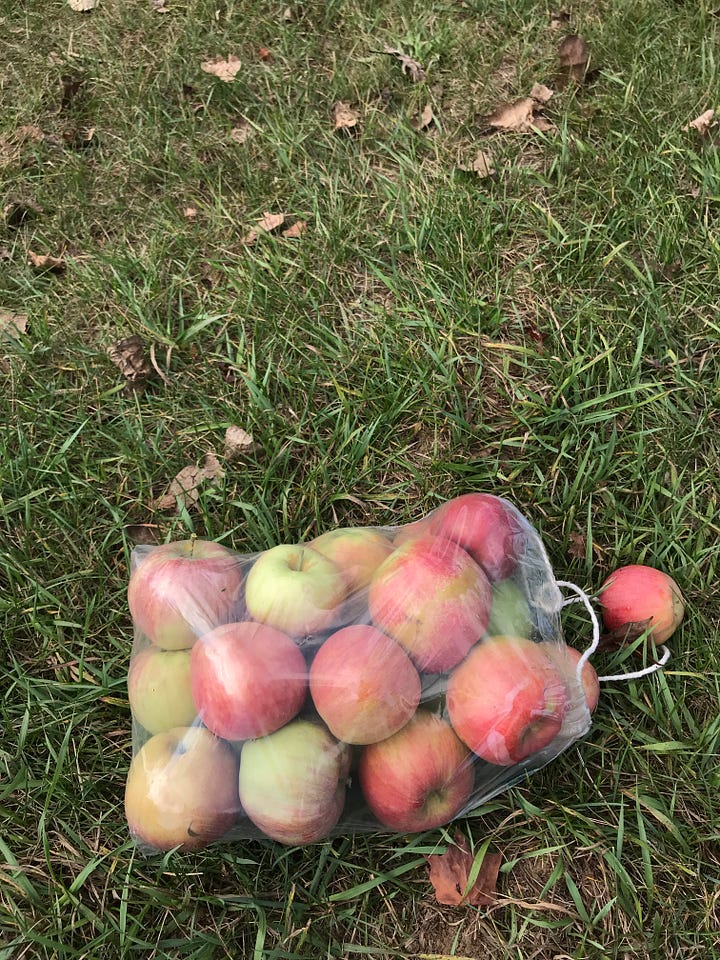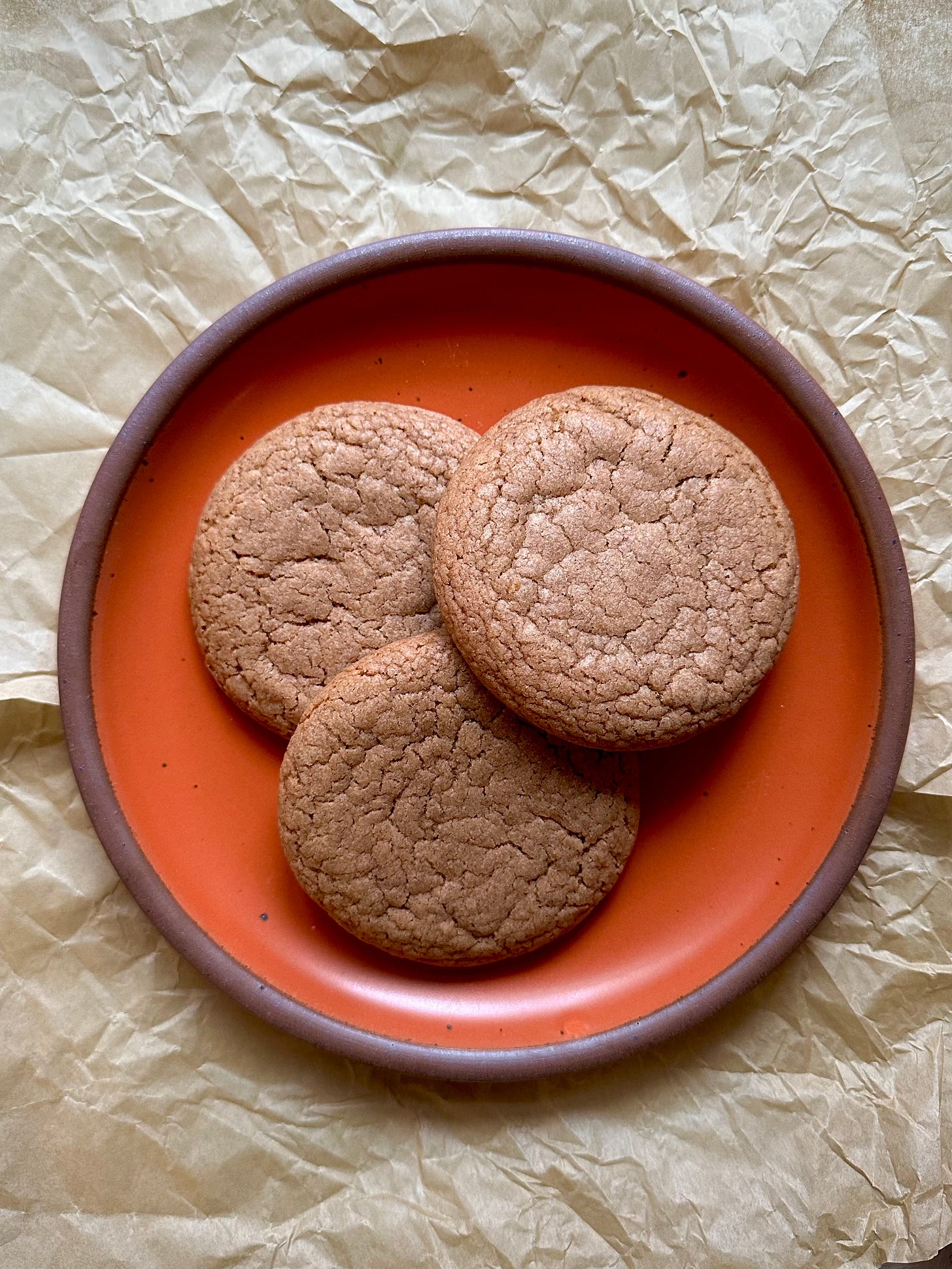Apple Butter Five Spice Cookies With Cider Vinegar Glaze
How to fit an entire apple into a cookie.
Hi everyone!
The mornings have been chillier and the nights are getting longer. It’s time to don our best flannels, pull out the thick socks, and pop open a new bottle of Vitamin D. We’ve made it to fall.
I’m sure your social feeds have already reached peak pumpkin content but I hope today’s recipe can inspire you to take the season more slowly by enjoying the early bounty of fall. Apples are here and just begging to be made into a crumble, a pie, or even a cookie! Trust me, there will be plenty of time for pumpkins and related gourds over the coming months. 🎃
When I set out to make a cookie that tasted like the early days of fall, I knew apple was the ingredient that should be the star of the show. Picking apples was an experience I first had in Michigan and it left a strong impression on me. There's something really beautiful about exploring the bounty and variety of an apple orchard at its peak. A reminder of how the produce section at the grocery store isn’t the origin but rather the midway point in a long story from tree limb to dinner plate. Outside of U-pick farm stands and apple orchards, rarely do we get the experience of being the first and only person to handle the food we eat. It always feels like it awakens a deeper connection to something kept shrouded by modern times and conveniences.





What I didn’t know when I originally planned to fit an apple into a cookie was how tricky it would be to make a cookie that I would actually like to eat. The first few tries produced something more like a disappointing muffin top - unappealingly soft and damp with very little crunch or crispness. Six tries later and i’m very proud of where this recipe landed. While it may seem fussy, it comes together by hand in less than an hour and I’m hopeful the first bite will have you excitedly itching for a hayride, corn maze, or pumpkin patch photoshoot.
Apples contain A LOT of water. In fact, apples are about 85% water. Most cookie recipes contain water too - via eggs, butter, and the small amount of water found in both white and brown sugar. Generally, the higher amount of water in a cookie recipe, the softer/cakier the resulting cookie will be. I’m not the biggest fan of soft cookies so I had a challenge set before me to deliver an apple cookie with crisp edges and a chewy center, my much preferred cookie texture by far. Luckily I didn’t need to reinvent the wheel and could rely on some helpful tricks i’d learned from other bakers that i’ll share with you now.
Eggs
Your standard large chicken egg is about 75% water. Breaking that down further - the egg white is 88% water while the yolk is 55% water. The proteins found in eggs help provide structure and the water creates steam which adds lift to cookies and other baked goods. A cookie without eggs would lean more towards being a shortbread -not a bad cookie at all, but not the goal today.
Removing the egg whites rids the cookie of a lot of extra water. This also lets the yolk’s two main properties shine through: emulsification and structure (via lecithin) and richness (via fat). With just a single yolk, these cookies come out extra chewy but not dense.
Butter
Your typical American store-bought butter is about 80% to 82% fat. Water makes up the remaining 16% to 17.5% while salt and milk solids (vitamins, minerals, and a tiny bit of lactose) make up the last 1% to 1.5%.
The easiest way to remove the water content from butter is to melt it. When the butter is heated to 212F (100C) the water escapes as steam and if you continue to cook the butter to 266F (130C) and beyond, you wind up with browned butter - a delicious bonus created by the caramelization of the milk solids.
Jesse Szewczyk has a beautiful and expansive book all about cookies that includes a recipe for a spiced apple butter cookie. Brown butter is utilized in his recipe and I knew after my first attempt with regular softened butter that his approach was the wisest. You’ll see brown butter’s rich toffee-like flavor featured prominently in autumnal baking. Also, the flavor pairs well with the tart glaze I used to finish these cookies.
Apple Butter
Alright, we’re in the home stretch. We can finally address the elephant in the room. The one who brought all this water to the party.
Apple Butter is essentially a cooked down puree of apples. Sometimes apple butter is sweetened with sugar and sometimes it includes the traditional spices you often see accompany apples like cinnamon, clove, and nutmeg. But at the end of the day, apple is the star. Apple butter can be purchased like a jam or jelly and usually pops up on shelves during this time of year. Apple Butter can also be made at home. Rather than peeling and processing pounds of apples, I like this clever recipe that uses applesauce as a shortcut to making the more concentrated and flavorful apple butter.
To even further rid my cookie of pesky water, I took a trick from Rose Levy Beranbaum who’s Pumpkin Pecan Cookie recipe from her book, The Cookie Bible instructs you to cook the pumpkin puree down with sugar until a thick glossy paste is created. I figured that the technique could work for apple butter and was happy to find that it did. The resulting mixture not only smells divine but the flavor of the apple butter becomes even more concentrated, allowing it to stand up to the spices added later. Allowing the sugars to dissolve with the apple butter also applifies the cookie’s chewiness. This same sugar-dissolving technique is often found in brownie recipes, creating a fudgey texture with a glossy surface after baking.
A Few Notes…
Five Spice is a common spice blend from Chinese cuisine that’s also found in Taiwanese and Vietnamese cooking. It’s usually used as a rub on meats like pork or duck. Traditionally, the five spices are cinnamon, clove, fennel, star anise, and Sichuan peppercorns but some western market blends swap the peppercorns for white pepper or even ginger. Regardless, any brand should work here. You can also swap the five spice for an equal amount of cinnamon.
If you bake these cookies right after mixing they’ll come out pretty flat with crispy edges. If you let the scooped cookies rest for an hour at room temperature or in the fridge for 30 minutes, you’ll get a thicker, chewier cookie.
The tart glaze recipe is inspired by Natasha Pickowicz. It balances the spice in the cookie and makes it feel like you’re biting into a tart apple. Light or dark soy sauce will work in the glaze but dark soy sauce will produce a stronger color difference.
These cookies keep really well after being glazed. The texture gets better and better over two to three days. I recommend storing them in an airtight container for no longer than five days though.
Apple Butter Five Spice Cookies
makes 11 to 13 cookies depending on size
113g unsalted butter
80g apple butter
65g light brown sugar
125g white sugar
23g molasses
1 large egg yolk
154g all purpose flour
65g whole wheat flour
1/4 teaspoon baking soda
1/2 teaspoon baking powder
1/2 teaspoon kosher salt
1 1/2 teaspoon five spice powder
Marbled Vinegar Glaze
150g powdered sugar, divided
7 1/2 teaspoons apple cider vinegar, divided
1/2 teaspoon soy sauce, light or dark
1 teaspoon five spice powder (optional)
Have a medium sized bowl at the ready. In a small lightly colored sauce pan, add the butter and cook over medium heat. Continue cooking, stirring frequently until the butter stops bubbling and the small flecks of milk solids at the bottom of the pan begin to turn copper/light brown. Pour the browned butter into the medium bowl and set aside.
Wait for the sauce pan to cool slightly then add the apple butter, both sugars, and molasses. Return to medium heat and stir until the sugar dissolves and the surface is shiny and beginning to bubble, 2 to 3 minutes. Be careful not to cook the mixture too long, or you will turn it into candy. You just want to dissolve the sugars and create a homogenous mixture. Pour into the bowl with the browned butter and allow to cool for 30 minutes, stirring occasionally.
Preheat the oven to 350F with a rack in the middle position. Line a sheet tray with parchment paper and set aside. In a medium bowl combine the flours, baking soda, baking powder, salt, and five spice powder.
Whisk the egg yolk into the cooled butter and sugar mixture, being sure to thoroughly combine but not to incorporate too much air. Stir in the dry ingredients with a rubber spatula until no dry streaks remain. The mixture will be stiff and will require more mixing/folding than the typical cookie batter.
Using a 2 to 3 tablespoon cookie scoop, portion the cookies onto the prepared sheet tray about 3 inches apart. Bake for 13 to 15 minutes or until the surface is matte and crackled and the edges are firm and just slightly more golden than the centers. Baking 5 to 6 cookies per tray works best. Allow the cookies to cool completely on the tray before moving to a wire rack to be glazed.
Marbled Vinegar Glaze
In two small bowls, divide the powdered sugar evenly. (75g per bowl)
Carefully measure 4 teaspoons of apple cider vinegar into one of the bowls and whisk until you have a glaze with the consistency of heavy cream.
Into the other bowl, whisk in 3 1/2 teaspoons vinegar and 1/2 teaspoon soy sauce. Whisk until combined with no lumps.
Using a small spoon, alternate drizzling the two glazes onto each cookie being sure to cover the edges. (A little of the glaze goes a long way - you want a thin coating here) Sprinkle a small pinch of five spice powder onto the still wet glaze of each cookie, if desired. Allow the cookies to dry uncovered at room temperature for at least 1 hour to set the glaze.






Hey Jordan, did you perhaps mean 180g of apple butter instead of 80g? I tried making this with 80g and when the cooked mixture cooled, it turned rock hard 🥲
In the middle of making these and the dough tastes delicious! Is it supposed to be on the drier side and a bit crumbly?